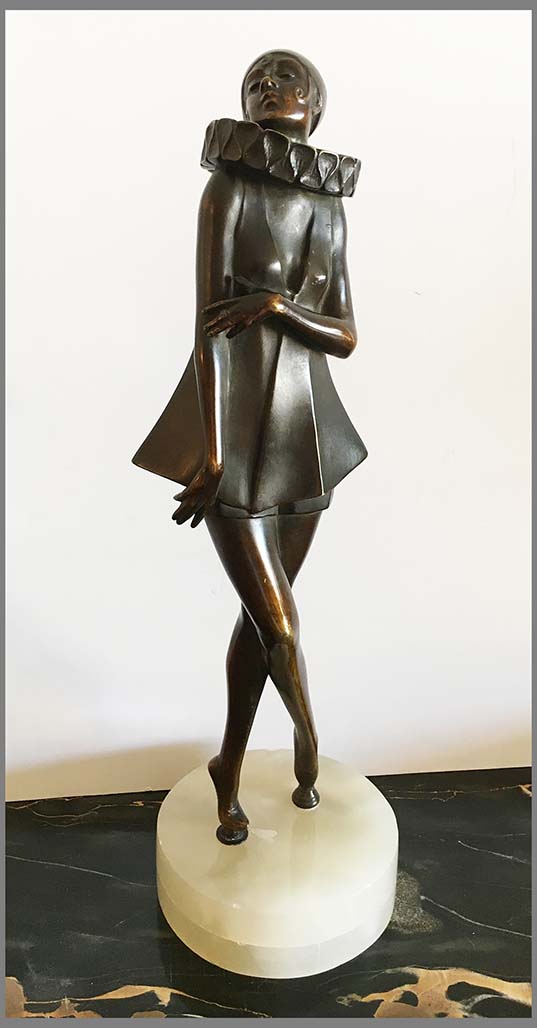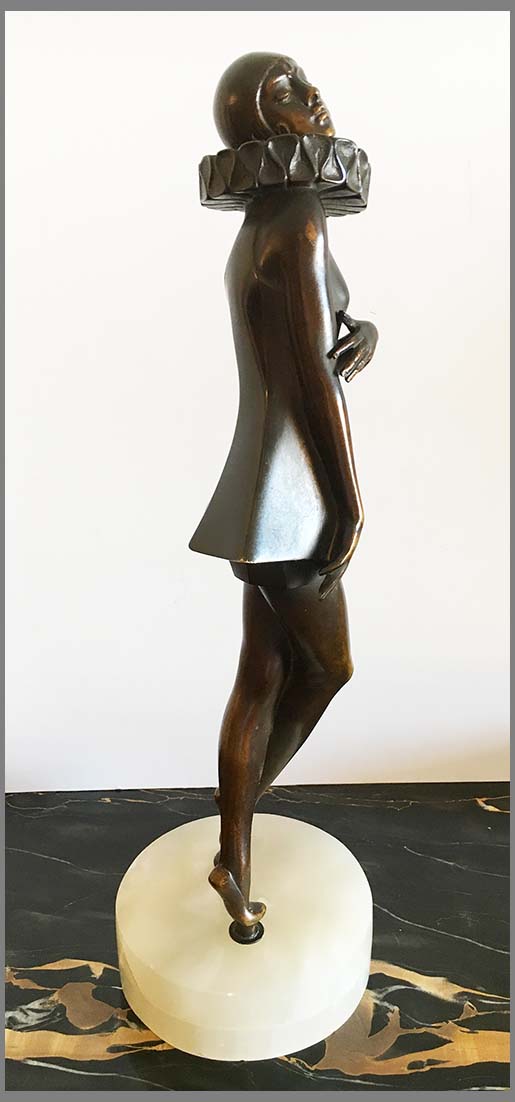



JOSEF LORENZL
"PIERROTTE"
BRONZE, SIGNED
FRANCE, C.1930
15.5 INCHES
Josef Lorenzl
1892-1950
When looking to the designs of the Art Deco* period one talented sculptor and ceramist that cannot be ignored is Josef Lorenzl. A master designer, he did bronze statuettes* and ceramic figural work which epitomized the era. As like Fritz Preiss, Demetre Chiaparus and Alexandre Kelety the other great sculptors from this period, Lorenzl was inspired by the female form and the new found freedom that women enjoyed, which he executed both in his bronze* and ceramic* designs.
Although very little is known about Lorenzl's early life, it is known that he was born in Austria in 1892 and that he became one of the recognized sculptors of the Art Deco Period. He started by working for a bronze foundry* in Vienna , where he produced stunning bronze statuettes. The majority of his works in bronze and ivory were of singular slim female nudes with long legs, which conveyed elegance. His preference was for dancing poses, which were not only evident in his singular statuettes but also in those attached to marble clocks, lamp bases and bookends.
Like his contemporaries Lorenzl work was created using "Chryselephantine", a Greek word that refers to the combination of various materials such as bronze, ivory, gold and silver. He signed his pieces in various ways sometimes abbreviating his name to "Lor" or "Enzl" but on some of the statuettes you will find an additional signature by Crejo. A talented painter who worked alongside Lorenzl, Crejo would paint decoration onto the statuettes such as flowers and these are the figures, which bear his signature and which have proven in the marketplace to add much value.
From his designs in bronze and ivory, Lorenzl went on to work for the Austrian ceramics company Goldscheider. Again creating sculptures of the female form, he began a creative period of which collectors seem more aware than his earlier period of bronze and ivory statuettes.
Inspired by shape and bold colors Lorenzl's sculptures have clean lines and geometric shapes. Although each piece possesses great movement, there seems to be no intricacy or attention to detail, and most of his figures wore their hair in the boyish bob which was fashionable at the time, making these simplistic and stylish figurines the epitome of Art Deco design.
One of Lorenzl's friends Stephan Dakon whom he had met whilst working at the bronze foundry had the same vision and style as Lorenzl, so it was the obvious thing for Lorenzl to recommend Dakon to Goldscheider when he started to work for them. Taken on as a freelance designer, Dakon was of the same mindset as Lorenzl, and so much of their work was very similar. People at the time even believed that the two were in fact the same person.
Both the artists had an interest in the female form, dance and theatrical costume. This was enhanced with Lorenzl when he took a trip to Paris and visited Follies Bergeres. Famous dancer Josephine Baker was on stage with her chorus dancers, all wearing extremely flamboyant costumes, and Lorenzl was captivated by the glamor and outlandishness of the dancers. As a result of this experience, on his return to Austria, Lorenzl reproduced gorgeous figurines with vibrant coloured costumes and in various dance poses.
Among his notable sculptures are Captured Bird, a dancing girl with gossamer winged dress image in many different colors and sizes. This piece was inspired by a dance performed by Niddy Impekoven and was also captured onto a lamp base with three figures of this elegant lady dancing around the stand. Other dancing girl figurines which were created by Lorenzl include Butterfly Wings, Spider-Web Dress and The Arabian Dancer. Not only did all his creations represent the elegant and feminine side of a women, but each seemed seductive in a subtle way.
Adapting his theme of dance, Lorenzl also went on to produce the Egyptian Dancer or Odalisque in 1922. This particular piece was again reproduced with models wearing different colored shawls and is one of the most recognizable figures today.
By the 1930's Lorenzl and Dakon were the principle designers at Goldscheider, although there were many freelancers employed by the firm. It is here that we see another slight change to Lorenzl's work. Although he had used the naked female form in much of his bronze and ivory works, it was during this period that he started to produce his mildly erotic yet beautiful nude figurines for Goldscheider. Awaken and Nude with a Borzoi are perfect examples of Lorenzl's talent for taking the naked female form and making it glamorous yet sophisticated.
Although the majority of Lorenzl's sculptures for Goldscheider were females, he experimented with other ideas. Mephistopheles was a figure of the devil dressed in theatrical costume, and shows his passion for theatre, costume and the arts.
Lorenzl is considered the most important Goldscheider artist in the Art Deco period as his distinctive and stunning figurines are highly sought after by collectors. A celebrated sculptor with an eye for design, Lorenzl epitomized the Art Deco era perfectly making him one of the most celebrated and iconic designers of the 20th Century.